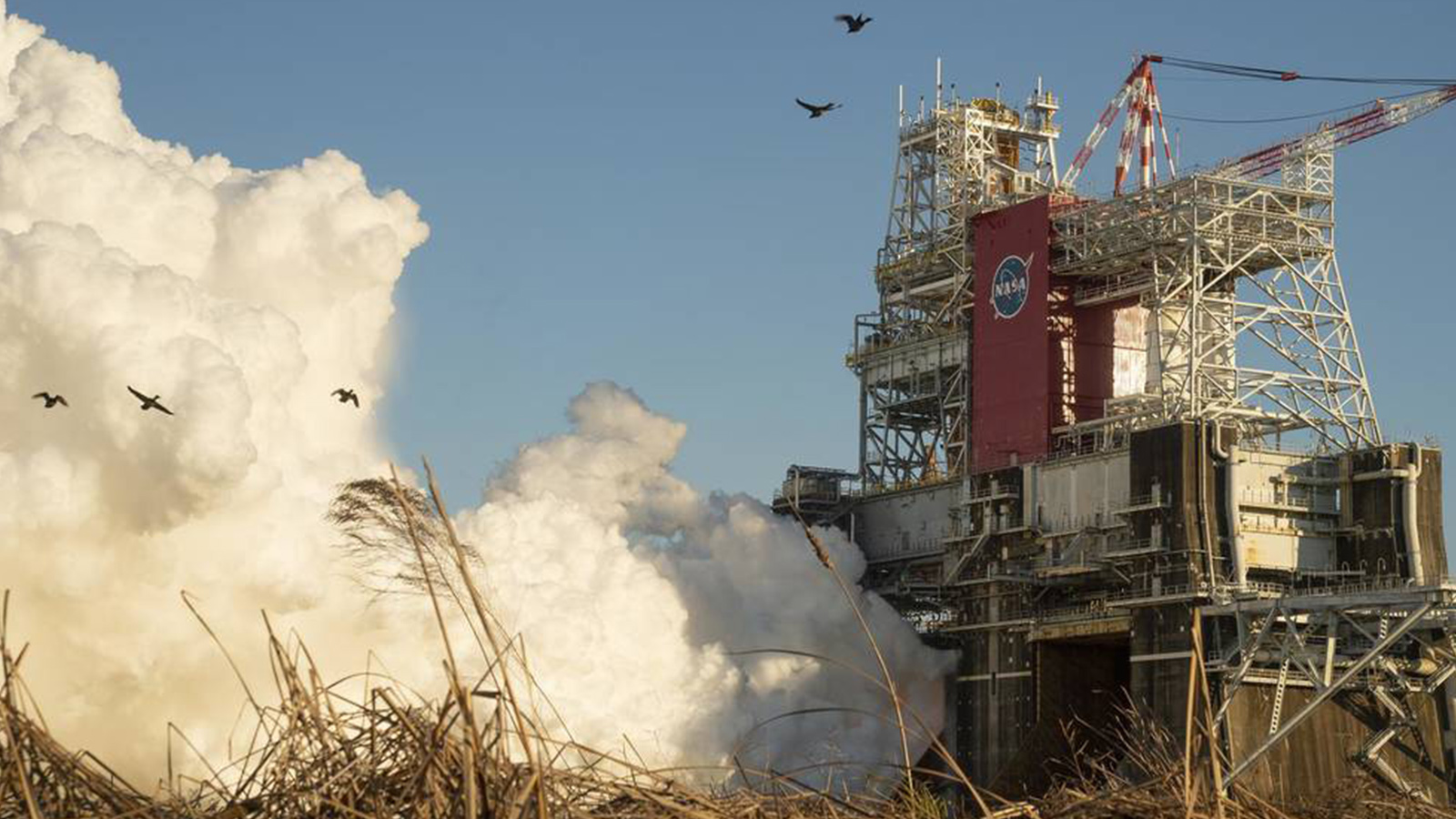Stay Up to Date
Submit your email address to receive the latest industry and Aerospace America news.
Shuttle procedures were starting point toward March 18 bid to complete the critical firing milestone
UPDATE: The engines on the SLS core stage fired for eight minutes on March 18, and NASA declared the hot fire “successful.” Engineers and technicians are now refurbishing the core stage and its engines for transport to NASA Kennedy Space Center in mid-April.
When the engines for NASA’s first Space Launch System rocket shut down prematurely in their hot fire attempt two months ago, Aerojet Rocketdyne technicians rushed in almost immediately to begin refurbishing the engines for a second try.
There was no time to waste, given that the shutdown, which came just 67.2 seconds into the planned eight-minute burn, amounted to an unexpected hurdle in front of NASA’s plan to conduct the long-delayed SLS inaugural flight in November without a crew. NASA can’t launch that first SLS rocket until a successful hot firing of the Boeing-supplied core stage consisting of four Aerojet Rocketdyne RS-25 engines and cylindrical liquid hydrogen and liquid oxygen propellant tanks. In a sense, NASA’s entire Artemis moon program hinges on completing the eight-minute burn, now scheduled for Thursday.
For the refurbishment, engineers and technicians followed largely the same inspection and cleaning procedures established decades ago for the space shuttle program’s RS-25s, although Aerojet Rocketdyne did make a few changes for expediency, deputy program manager Doug Bradley told me.
The biggest was leaving the engines and core stage bolted to the B-2 test stand at NASA’s Stennis Space Center in Mississippi. During the shuttle era, Aerojet Rocketdyne would remove the engines from each orbiter, taking them to a facility at NASA’s Kennedy Space Center in Florida for repairs. That was easier because “we had a number of engines, typically about 12 engines in the engine shop” to repair at a given time, Bradley said. With only four engines on an SLS core stage, “it makes more sense to leave them on” during refurbishment.
As a first step after the January hot fire, Aerojet Rocketdyne technicians needed to remove the moisture inside the bell-shaped nozzles leftover from burning cryogenic liquid hydrogen fuel with liquid oxygen oxidizer to produce water vapor as the exhaust. Technicians pumped heated nitrogen gas into each nozzle cavity via large hoses and blasted it “like a large blow dryer,” Bradley said.
Once humidity gauges confirmed the moisture was gone, technicians moved onto visually inspecting the exterior and interior of each nozzle for cracks or discoloration. Technicians also routed flexible, camera-equipped borescopes into engine components, including the external turbo pumps above the nozzle that route fuel and oxidizer into the thrust chamber. They concluded their inspections by examining components such as fuel lines for leaks. None were found, Bradley said.
In total, refurbishment of the four engines took about 30 days, Bradley said. Aerojet Rocketdyne expects the next refurbishment to take about the same amount of time, although in this instance, they hope it’s in preparation for the inaugural flight. If all goes as planned Thursday, NASA and its contractors will spend the following days analyzing the data and inspecting the core stage, making any needed repairs. The stage will then be loaded onto a barge for shipping to Kennedy, where it will be joined with the rest of the SLS hardware, including the two Northrop Grumman solid rocket boosters that engineers finished stacking earlier this month.
In the January attempt, the SLS flight computers shut down the engines because pressure in the hydraulics that steer the rocket by gimbaling, or pivoting, the engine nozzles “exceeded the pre-set test limits” that were “intentionally conservative,” NASA said in a blog post.
In the event of another shortened test, the hot fire could still be deemed successful, said John Shannon, Boeing’s SLS program manager, during a pre-test briefing. “We’ll have really all the engineering data we need to gather after about 250 seconds of that firing.”
HOT FIRE DETAILS
WHAT: NASA broadcasts live from Stennis Space Center in Mississippi at nasa.gov/nasalive
WHEN: The two-hour test window opens at 2 p.m. (3 p.m. Eastern); NASA coverage will begin 30 minutes before the hot fire.
WHAT YOU’LL SEE: The RS-25 engines should ignite about six seconds before T-0. During the 485-second test, the SLS flight computers will periodically command the engine nozzles to gimbal, or pivot, as they would to adjust an SLS rocket’s trajectory during flight.
WHY? The hot fire is the last step in the 15-month-long Green Run, a series of tests in which NASA and Boeing had to power up the various hardware and flight control software of the SLS core stage to prove each element is ready for the first launch, an uncrewed flight meant to build confidence that an SLS rocket can safely send astronauts on their way to the moon under the Artemis moon program.
About cat hofacker
Cat helps guide our coverage and keeps production of the print magazine on schedule. She became associate editor in 2021 after two years as our staff reporter. Cat joined us in 2019 after covering the 2018 congressional midterm elections as an intern for USA Today.
Related Posts
Stay Up to Date
Submit your email address to receive the latest industry and Aerospace America news.




